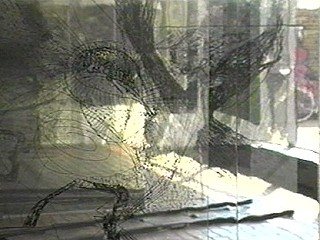Carlfriedrich Claus's sprachblatt or speech sheets, are forms of a writing/drawing mix, whereby text is fused with texture, and as you stand away from the image, texture begins to dominate text, but as you focus in, text becomes more important. So for instance at the scale of screen reproduction texture is more immediately apparent and the image can be read as a visual sound.
The use of language in visual poetry was a specialty of Carlfriedrich Claus, who developed his work in the early 1960s. He believed that the 'naturalised individual’ ought to live in harmony with a 'humanised natural world’ and his ideas mix European philosophy with Eastern mysticism and the writings of Marx. His text-drawings, often drawn on both sides of transparent sheets, illustrate both the processual and dialectal approaches to his ideas. For instance you might get two pages that set out a thesis and antithesis in order to arrive at some sort of synthesis; however no matter how hard you try to 'read' these images, it is hard to avoid the sense that their meaning will always be hidden.
'Aurora’ (1977)
This is how Claus wrote about his processes: "The production of speech sheets and of phoneme processes ran parallel. The speech sheets arose through my experimental use of my left hand (I am right-handed), and in doing so I noticed, first, the formation of internal blockages, like a psychological stuttering, and second, a different coloration of the content of my thought. (…) These phoneme processes or speech operations are not speaking in the sense of phonology, in which the specific scaffolding of a natural language must precede each act of speech. Here, the whole point is to break through this scaffolding, to break out of it or out of the prison of natural language, which determines in great part our relationship to the world. (…) Basically, the 'phoneme aggregate' suggests to the listener that he experiment with his own organs of speech and that he explore how various sounds, consciously articulated, affect his psychological state."
Carlfriedrich Claus: installation in the former Reichstag Building in Berlin
Carlfriedrich Claus at work
However it is in the work he did with sound that I think has the most potential to be revisited and thought about as a stimulus for students interested in contemporary drawing. Claus had been working on an installation from the 1950s to the 1990s, which addressed language as a written image and sound process. 'Lautaggregat K' used a spatial layer of sound, forming a 'sound aggregate', originally used for a WDR radio play, using a special stereophonic system; this sound material then forming the basis for a 1995 installation, in which several speech processes ran in parallel and were mixed at an editing desk. These layers of sound corresponded with the writing images, that were spatially arranged on transparent surfaces. The subject of the text dealt with philosophical themes, while the sound process itself was intended to be experienced physically. These two normally separate experiences, the intellectual and the physical being brought together.
Carlfriedrich Claus: sound processing room 1995
In his work there was a constant dialectical flip between reading, hearing and looking and he stated that his works aimed to impregnate ‘ways of seeing with lingual thinking’. Perhaps I have been reminded of his work because Sue has begun working towards a PhD and she was looking at how work she had done in the past when curating sound artists, is now being archived. Sometimes our interests feel very different, but they also touch at sometimes unexpected points and this work of Claus's is I think an interesting case. He now has his own archive, where his acoustic work is available on 15 reel-to-reel tapes and 267 cassette tapes and it would be interesting to see what issues and problems the archive has faced in reconstructing experiences of his work for those who visit.
The move towards a gesamtkunstwerk, whereby various elements of an artwork come together to create a totality, is something that at one point or another many artists consider, because by the nature of things artists try out various approaches to communicating related ideas. This often leaves you with a diverse body of work that only seems to make sense when the various elements are collected together. For myself the drawings Claus produced make far more sense when coupled with the sound pieces he made. I think in my own case my drawings make more sense when shown alongside my ceramics, prints and written work, but how to organise all the elements is at present something I'm not sure how to do, I need curatorial advice.








No comments:
Post a Comment